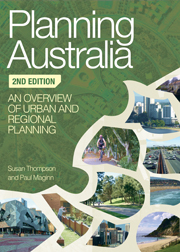Book contents
- Frontmatter
- Contents
- Contributors
- Figures and tables
- Discussion points and case studies
- Preface
- Acknowledgments
- Abbreviations
- Table of statutes
- Introduction
- Part I Frameworks
- Part II Key Issues
- 6 Planning and the natural environment
- 7 The metropolis
- 8 Planning for rural landscapes
- 9 Planning for regions
- 10 Planning for diverse communities
- 11 Aboriginal and Torres Strait Islander Australians
- 12 Community participation in planning
- 13 Urban design
- 14 Planning for heritage conservation and management
- 15 Transport planning
- 16 Healthy planning
- Conclusion: planning Australia into the future
- Index
- References
16 - Healthy planning
from Part II - Key Issues
- Frontmatter
- Contents
- Contributors
- Figures and tables
- Discussion points and case studies
- Preface
- Acknowledgments
- Abbreviations
- Table of statutes
- Introduction
- Part I Frameworks
- Part II Key Issues
- 6 Planning and the natural environment
- 7 The metropolis
- 8 Planning for rural landscapes
- 9 Planning for regions
- 10 Planning for diverse communities
- 11 Aboriginal and Torres Strait Islander Australians
- 12 Community participation in planning
- 13 Urban design
- 14 Planning for heritage conservation and management
- 15 Transport planning
- 16 Healthy planning
- Conclusion: planning Australia into the future
- Index
- References
Summary
Key terms: healthy built environments; healthy planning; public health; determinants of health; burden of disease; obesity; chronic disease; physical activity; social connection.
Although human health is a new connection for planning in Australia today, a century ago planning was strongly aligned with public health objectives to prevent the spread of infectious disease. This close relationship was not, however, sustained. Planning shifted its focus to urban policy development, design and environmental sustainability, while public health largely pursued a medical model (Botchwey et al. 2009). Today, we face a different set of health problems associated with our sedentary and automobile-dependent lifestyles, and the two disciplines are gradually re-aligning as evidence mounts about the critical role that the built environment plays in supporting human health.
So what makes a healthy place in Australia and how can planning contribute to the creation of such places? In this chapter we explore these questions– initially by defining the concept of ‘healthy planning’ and providing a brief overview of its evolution. Contemporary Australian health patterns are then presented, setting the context for considering the role of the environment in supporting good health as part of everyday life. The chapter concludes with key challenges for healthy planning.
- Type
- Chapter
- Information
- Planning AustraliaAn Overview of Urban and Regional Planning, pp. 381 - 408Publisher: Cambridge University PressPrint publication year: 2012
References
- 7
- Cited by



